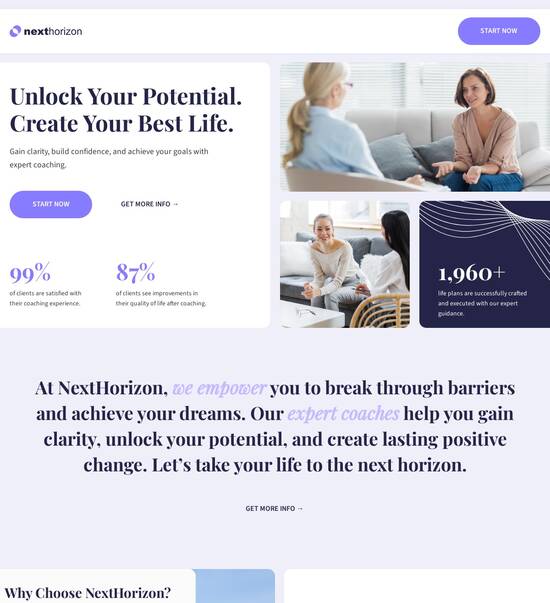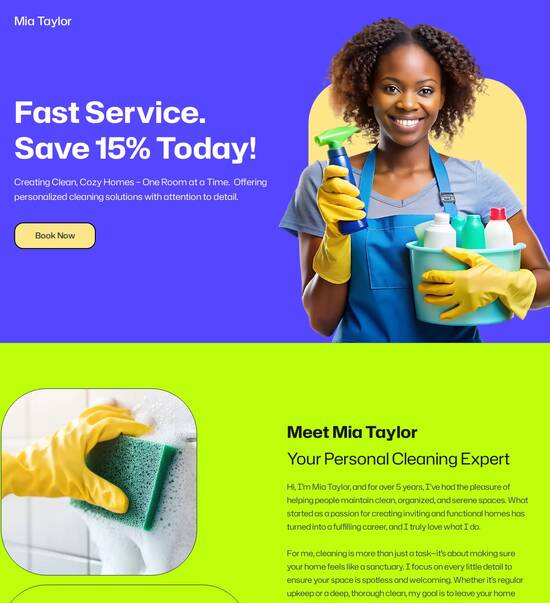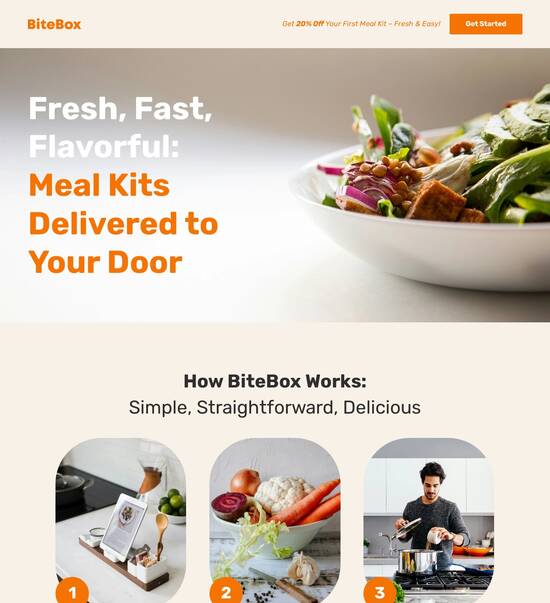
Web page template for Chemical Industry
Use TemplateAbout template
Conquer your niche with our high-converting landing page templates for your Chemical Industry business. Let's boost conversion rates together!
Recommended templates

Easy to build without coding
With the intuitive drag-and-drop builder, anyone on your team can create high-converting pages without any knowledge of code or design. Make enhancements to your landing page with custom widgets using Javascript, HTML/CSS, or third-party scripts.

Multiple layouts for any industry and goal
Select from 500+ landing page layouts built to boost conversions across industry-specific scenarios. Customize them by adjusting fonts, adding images, and generating on-brand content with the AI assistant. Quickly scale with Instablocks® and Global Blocks that you can save, reuse, and update globally.

Loads fast and looks polished on any device
Every template is responsive, which means they present professionally on any device and load blazingly fast with our Thor Render Engine. You can also power them up with Google AMP technology to deliver an unparalleled mobile experience and drive higher conversions.

Robust analytics & experimentation
Get real-time updates and reporting across all your devices, showing the number of visitors, conversions, cost-per-visitor, and cost-per-lead. Launch AI-powered experiments, run A/B tests, and use heatmaps to analyze user behavior, then optimize your landing page to maximize conversions.







Easy to build without coding
With the intuitive drag-and-drop builder, anyone on your team can create high-converting pages without any knowledge of code or design. Make enhancements to your landing page with custom widgets using Javascript, HTML/CSS, or third-party scripts.
Multiple layouts for any industry and goal
Select from 500+ landing page layouts built to boost conversions across industry-specific scenarios. Customize them by adjusting fonts, adding images, and generating on-brand content with the AI assistant. Quickly scale with Instablocks® and Global Blocks that you can save, reuse, and update globally.
Loads fast and looks polished on any device
Every template is responsive, which means they present professionally on any device and load blazingly fast with our Thor Render Engine.
Robust analytics & experimentation
Get real-time updates and reporting across all your devices, showing the number of visitors, conversions, cost-per-visitor, and cost-per-lead. Launch AI-powered experiments, run A/B tests, and use heatmaps to analyze user behavior, then optimize your landing page to maximize conversions.
All the features you need to build lead-generating landing pages
Explore more featuresLearn how to build top-performing landing pages for any goal
FAQs
Leading the way in building high-performing landing pages





A comprehensive guide to optimizing landing pages with Instapage
Instapage stands as the premier platform for creating landing pages tailored for digital marketing success. Its robust capabilities allow dive deep into conversion rate optimization (CRO), ensuring that marketers can effectively boost their ROI. This guide will walk you through a systematic approach to harnessing the full potential of Instapage for your campaigns.
Understanding the fundamentals of Instapage
Instapage is designed to simplify the complexities of landing page creation, making it accessible for teams of all sizes. With over 100 templates specifically optimized for conversions, you can easily tailor your campaigns to meet the unique needs of your audience. The collaboration features also foster real-time feedback, streamlining the approval process with external stakeholders.
- 100+ customizable templates: Choose from a vast array of conversion-focused layouts to jumpstart your campaigns.
- Built-in optimization tools: Use experimentation features like A/B testing to refine your landing pages continuously.
- Dynamic personalization: Leverage audience-specific content delivery to enhance engagement and conversion rates.
Step 1: Creating your landing page
To kick things off, start by selecting one of the pre-existing templates that align with your campaign goals. Instapage’s intuitive drag-and-drop builder enables marketers to craft pages without the need for coding.
Step 2: Optimize for conversions
Once your landing page is set up, focus on utilizing the optimization tools provided by Instapage. Below are crucial features to enhance your page's performance.
- Heatmaps: Visualize user interactions and adjust the layout to highlight the most engaging elements.
- A/B testing: Experiment with different headlines and calls to action to find what resonates best with your audience.
- Analytics dashboard: Track performance metrics to gauge the effectiveness of your optimizations.
Step 3: Personalize and collaborate
After you've optimized your page, take advantage of Instapage's personalization features to deliver tailored experiences. This step ensures that your content resonates with target audience segments, increasing the likelihood of conversion.
- Dynamic text replacement: Automatically tailor headlines to mirror search queries for increased relevance.
- AdMaps: Align your advertising campaigns with specific landing pages to maximize traffic quality.
- Collaboration tools: Enable seamless communication and feedback collection among your team to enhance page production.
By following these steps, you can create landing pages that not only attract visitors but also convert them into leads or customers.
Ready to transform your landing pages and maximize your campaign's performance? Start your free trial with Instapage today and see the results for yourself!
People also ask about Web page template for Chemical Industry
Web page template for chemical industry: A guide to effective digital presence
Understanding the unique landscape of the chemical industry
The chemical industry operates within a complex regulatory environment characterized by stringent safety protocols and compliance requirements. Businesses in this sector must navigate intricate frameworks that govern manufacturing, transportation, and environmental impact. As a result, web page templates tailored for this industry must address these unique characteristics to attract niche B2B audiences effectively.
Additionally, stakeholder engagement is critical, as the audience often includes a variety of professionals from research and development to procurement. The digital marketing strategies employed must cater to these specific roles while promoting safety and compliance as top priorities. Thus, the template must facilitate a deeper understanding of product specifications and regulatory adherence.
Complex regulatory frameworks necessitating thorough compliance information.
Niche audiences with diverse information needs spanning research, engineering, and purchasing.
A strong emphasis on safety protocols, with visuals and content that highlight industry standards.
In the chemical sector, digital marketing is unique due to the highly technical nature of the content. This demands a sophisticated understanding of SEO practices, as appropriate keywords must target specific industries and applications. Furthermore, visual elements play an important role in simplifying complex data, thereby making it more digestible for users. Overall, a well-designed web page template can significantly enhance visibility in search engines and improve stakeholder engagement.
Features of a dedicated web page template for the chemical industry
Creating a dedicated web page template for the chemical industry involves several tailored design elements. First and foremost, color palettes must reflect the brand identity of the company while aligning with themes of safety and environmental consciousness. This can involve using greens and blues, which are often associated with eco-friendliness, safety, and trust.
Moreover, the layout should be pre-designed to accommodate scientific content effectively, with sections specified for technical specifications, product details, and compliance documentation. By providing users with straightforward navigation, they can easily find the information they seek, which is vital for ensuring a positive user experience.
Customizable color palettes to reflect brand identity and align with industry themes.
Pre-designed layouts for scientific content including technical specifications.
Sections dedicated to safety protocols, compliance documentation, and product details.
Responsive design is another critical component, ensuring that the template is mobile-friendly. As many stakeholders may access websites on their phones or tablets, it’s essential that the design adapts smoothly across all devices. Additionally, accessibility features must be integrated to accommodate diverse user needs, which includes adjustable font sizes and high-contrast color options for better visibility.
Functional capabilities of the template
A successful web page template dedicated to the chemical industry should also prioritize dynamic content loading. By utilizing JavaScript functionalities such as `document.addEventListener`, the template can incorporate interactive elements that enhance user engagement. For example, real-time updates on product specifications or compliance changes can be displayed effectively, keeping users informed and engaged.
Smooth transitions and animations can be employed to showcase complex data visually. This could include infographics detailing chemical processes or interactive charts that break down statistics related to safety compliance. Such visual engagement can make data more relatable and easier to understand for users.
Interactive elements utilizing real-time updates for better engagement.
Smooth transitions and animations to visually present complex data.
Streamlined navigation structures to enhance overall user experience.
Furthermore, an FAQ section optimized for common industry queries will improve user experience by offering quick links to relevant resources and documents. This direct access to information can alleviate concerns regarding safety and compliance while positioning the company as an authoritative source in the industry.
Optimization features for performance and engagement
Web page templates for the chemical industry must incorporate SEO best practices from the outset. This involves strategic keyword integration that caters specifically to niche markets within the chemical sector. Additionally, using schema markup for chemical products can improve visibility on search engines, guiding potential clients to the most relevant sections of the site efficiently.
Meta descriptions should also be tailored to industry-specific use cases, thus enhancing click-through rates. To ensure ongoing performance tracking, integrating Google Analytics is essential. This tool can provide valuable insights into user behavior, conversion rates, and the effectiveness of marketing strategies.
Incorporating strategic keyword integration for improved visibility.
Using schema markup for better search engine recognition of chemical products.
Integrating Google Analytics for real-time performance tracking and insights.
Moreover, optimizing images and scripts is crucial to achieve faster loading times. Given that users often have limited patience for buffering pages, caching strategies can enhance responsiveness, benefiting user engagement significantly. This combination of optimization techniques ultimately supports a seamless browsing experience.
Leveraging landing pages to drive engagement
Landing pages can play a fundamental role in driving user engagement within the chemical industry. To start, crafting compelling call-to-action (CTA) strategies tailored to industry stakeholders is essential. CTA wording must speak directly to the audience’s needs, whether they are looking for safety data, product specifications, or compliance information.
The strategic placement of CTAs throughout the web page can guide users on their journey. For example, CTAs offering free resources or downloadable content related to regulatory compliance can encourage users to provide their contact information, thereby facilitating lead generation. Furthermore, A/B testing functionalities should be embedded within the landing page template to identify top-performing layouts and CTAs.
Crafting persuasive CTAs tailored to industry-specific needs.
Using A/B testing to identify effective layouts and CTAs.
Creating personalized user journeys based on segmentation.
Finally, employing techniques for segmenting audience types allows for tailored content that aligns with users’ specific interests and behaviors. As users navigate the site, dynamic content can adjust based on their previous interactions, ultimately enhancing relevance and increasing conversions.
Real-life implementation case studies
Examining success stories from the chemical sector provides insights into how tailored web templates can yield measurable outcomes. For example, companies that have utilized specialized landing pages tailored to their unique offerings often report improved conversion rates and enhanced stakeholder engagement. The focus on user-centric design and functional capabilities, paired with targeted SEO strategies, significantly boosts their digital marketing efforts.
Lessons learned from these case studies highlight common challenges faced in digital marketing within the chemical sector, such as overcoming the inherent complexity of content and needing to convey compliance effectively. However, innovative strategies that emerged from these challenges offer a roadmap for others aiming for similar success.
Success stories showcasing increased conversion rates through tailored templates.
Common challenges faced and how they were addressed with innovative strategies.
Best practices derived from the effective implementation of landing pages.
Future trends and innovations in web presence for the chemical industry
Emerging technologies are set to play a critical role in shaping the future of web presence within the chemical industry. Artificial Intelligence (AI) can enhance content personalization, allowing companies to tailor their messaging to the distinct needs and preferences of individual users. This level of customization improves user engagement metrics and reinforces brand trust among industry stakeholders.
Moreover, integrating virtual and augmented reality applications for product demonstrations can transform how chemical companies engage with customers. Virtual reality, for example, can offer immersive experiences that simulate chemical processes, allowing potential clients to understand product functionalities interactively. This layer of engagement can set companies apart in a competitive market.
Adopting AI for enhanced content personalization tailored to user needs.
Utilizing virtual and augmented reality applications for engaging product demonstrations.
Enhancing customer-centric approaches through responsive feedback features.
Through these innovations, companies can create effective feedback loops that gather insights continuously, allowing them to forecast industry needs and adapt their web strategies accordingly. This focus on innovation will set the pace for ensuring that web presence evolves with the chemical industry.
Best practices for maintaining an effective web template
Regular updates and content management play a critical role in maintaining an effective web template for the chemical industry. This includes regularly refreshing content to keep it aligned with compliance updates, safety regulations, and other industry developments. By ensuring current information is readily available, companies can reinforce their authority in the marketplace.
Staying engaged with industry trends is equally important. Companies can benefit from connecting with thought leaders, attending conferences, and investing in continuous education. Understanding market dynamics and adjusting strategies based on analytics will help drive growth and conversions effectively. These best practices form the backbone of a robust digital presence.
Implementing regular content updates to ensure compliance and relevance.
Engaging with industry thought leaders and continuous educational opportunities.
Utilizing analytics to adapt strategies according to evolving market dynamics.
Ready to skyrocket conversions?
Supercharge your ad campaigns with high-performing landing pages
Get started














